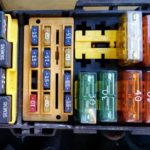Quick Navigation
- Where Can I Find the Holden Combo Fuse Box?
- Holden Combo – Identification of the Different Fuses and Their Functions
- 1. Radiator Fan (Fuse 6)
- 2. Central Locking System (Fuse 7)
- 3. Windscreen Wash System, Tailgate (Fuse 8)
- 4. Heated Rear Window, Heated Exterior Mirrors (Fuse 9)
- 5. Diagnostics Plug (Fuse 10)
- 6. Windscreen Wiper (Fuse 14 and 15)
- 7. Horn, ABS, Brake Light Switch, Air Conditioning System (Fuse 16)
- 8. Diesel Filter or Air Conditioning System (Fuse 17)
- 9. Starter (Fuse 18)
- 10. Horn (Fuse 20)
- 11. Engine Electronics (Fuse 21, 22, 26 & 30 )
- 12. Headlight Range Adjustment (Fuse 23)
- 13. Fuel Pump (Fuse 24)
- 14. Heating, Air Conditioning System, Air Quality Sensor (Fuse 27)
- 15. Power Steering (Fuse 29)
- 16. Rear Screen Wiper (Fuse 31)
- 17. Brake Light Switch (Fuse 32)
- 18. Headlight Range Adjustment, Instrument Assembly, Light Switch, Driver’s Door Module & Clutch Switch (Fuse 33)
- 19. Control Unit, Steering Column Module (Fuse 34)
- Warning About the Dangers of Working with Electrical Systems
- Conclusion
Are you the proud owner of a Holden Combo? If so, you’re in the right place!
This blog post is all about one of the most important components of your vehicle – the Holden Combo fuse box.

Now, you might be thinking, “Oh, a fuse box, that sounds boring.” But trust us, it’s pretty cool!
The Holden Combo fuse box is responsible for protecting all the electrical circuits in your car from damage.
This post shows you how to identify and replace a blown fuse with diagrams, as well as where the fuse box is.
Plus, we’ll make it easy and fun! So, grab a cup of coffee, and let’s dive in!
Where Can I Find the Holden Combo Fuse Box?
The Holden Combo fuse box is typically located under the dashboard on the driver’s side of the vehicle.
It may also be found in the engine compartment, depending on the year and model of the Combo.
To access the fuse box, you will need to remove the cover by pressing down on the locking tabs.
You can also or by using a screwdriver to remove any screws that may be holding it in place.
Removing the cover reveals the fuse layout and the diagram that explains their functions.
Consult the owner manual for the exact fuse box location as it may vary by model and year.
Holden Combo – Identification of the Different Fuses and Their Functions

Here’s a brief explanation of the most common fuses in the Holden Combo fuse box.
Be sure to consult the fuse box diagram for the uses of any fuse not discussed in detail.
1. Radiator Fan (Fuse 6)
This fuse controls the radiator fan, which cools the engine by blowing air over the radiator.
A blown radiator fan fuse can cause the engine to overheat, which can result in engine damage.
2. Central Locking System (Fuse 7)
This fuse controls the central locking system, which locks and unlocks the vehicle’s doors. A blown central locking system fuse can result in the doors not locking or unlocking properly or not locking or unlocking at all.
3. Windscreen Wash System, Tailgate (Fuse 8)
This fuse provides power to the windscreen wiper motor, which controls the movement of the wiper blades on the front windshield.
If the wiper blades stop working or only work intermittently, replacing this fuse might help.
4. Heated Rear Window, Heated Exterior Mirrors (Fuse 9)
Fuse 9 controls the electrical circuit that powers the heated rear window and heated exterior mirrors.
If the fuse blows, the heated rear window and heated exterior mirrors may not work and may need to be repaired or replaced.
5. Diagnostics Plug (Fuse 10)
The diagnostics plug fuse controls the power supply to the diagnostics plug, ensuring that it functions properly.
A blown diagnostics plug fuse can result in the diagnostics plug not functioning or not providing accurate diagnostic information, making it difficult for technicians to diagnose and repair the vehicle’s electronic systems.
6. Windscreen Wiper (Fuse 14 and 15)
These fuses control the windshield wipers, which clean the windshield. A blown windscreen wiper fuse can result in the wipers not functioning properly or not functioning at all.
7. Horn, ABS, Brake Light Switch, Air Conditioning System (Fuse 16)
This fuse provides power to multiple systems in the vehicle, including the horn, ABS, brake light switch, and air conditioning system.
If any of these components fail to work, this fuse may need to be replaced.
8. Diesel Filter or Air Conditioning System (Fuse 17)
This fuse provides power to either the diesel filter system or the air conditioning system, depending on the type of vehicle.
If the diesel filter system fails to work or the air conditioning system stops blowing cold air, you’ll need to replace this fuse.
9. Starter (Fuse 18)
This fuse provides power to the starter motor, which is responsible for turning over the engine when you start the car.
If you turn the key and nothing happens, or if the engine cranks but does not start, this fuse may be the culprit.
10. Horn (Fuse 20)
This fuse provides power to the horn, which is used to alert other drivers on the road with a loud honking sound. If the horn stops working, replacing this fuse might help.
11. Engine Electronics (Fuse 21, 22, 26 & 30 )
These fuses protect the engine control system and engine management components, which include the engine control module (ECM), ignition system, fuel injectors, and sensor inputs.
A blown engine electronics fuse can cause issues with starting, stalling, or poor engine performance.
12. Headlight Range Adjustment (Fuse 23)
This fuse controls the adjustment of the headlights, including their up and down movement.
A blown headlight range adjustment fuse can result in the headlights not adjusting properly or not adjusting at all.
13. Fuel Pump (Fuse 24)
This fuse controls the fuel pump, which supplies fuel from the fuel tank to the engine. A blown fuel pump fuse can cause the engine to not start or run poorly due to a lack of fuel.
14. Heating, Air Conditioning System, Air Quality Sensor (Fuse 27)
This fuse controls the heating, air conditioning, and air quality sensor, which monitors the air quality inside the vehicle.
A blown heating, air conditioning system, or air quality sensor fuse can result in the heating and air conditioning system not functioning properly, or the air quality sensor not working.
15. Power Steering (Fuse 29)
This fuse controls the power steering system, which helps the driver steer the vehicle more easily.
A blown power steering fuse can result in the vehicle having much harder steering, making it difficult to turn.
16. Rear Screen Wiper (Fuse 31)
This fuse controls the rear windshield wiper, which cleans the rear windshield.
A blown rear screen wiper fuse can result in the rear wiper not functioning properly or not functioning at all.
17. Brake Light Switch (Fuse 32)
This fuse controls the brake light switch, which activates the brake lights when the brake pedal is pressed.
A blown brake light switch fuse can result in the brake lights not functioning properly or not functioning at all.
18. Headlight Range Adjustment, Instrument Assembly, Light Switch, Driver’s Door Module & Clutch Switch (Fuse 33)
This fuse controls various lighting and control systems, including the light switch, adjustment on the headlight range, instrument assembly, clutch switch, and driver’s door module.
A blown fuse 33 can result in various lighting and control systems not functioning properly or not functioning at all.
19. Control Unit, Steering Column Module (Fuse 34)
The Control Unit, Steering Column Module (Fuse 34) protects the control unit and steering column module.
The control unit is responsible for managing various systems and components within the vehicle, such as the lighting, climate control, and entertainment systems.
A blown Control Unit, Steering Column Module fuse can result in various systems not functioning properly or not functioning at all, as well as issues with steering.
Warning About the Dangers of Working with Electrical Systems

- Always disconnect the battery before working on the fuse box or any other electrical component to avoid electrical shock or injury.
- Wear protective gear such as rubber gloves and safety glasses.
- Always consult the owner’s manual or a professional mechanic before attempting any repairs or maintenance on the fuse box.
Conclusion
The Holden Combo’s fuse box protects the vehicle’s electrical system from power surges and short circuits.
It can be found under the dashboard and in the engine compartment. The layout of the fuses includes labels or numbers, with a diagram that explains their functions.
To keep the fuse box in good condition, keep it clean and use the correct type of fuse.
If you have any concerns, consult the owner’s manual or a professional mechanic.
Remember to exercise caution and follow safety precautions when working with electrical systems.

James has been a car enthusiast since his childhood when he learned the differences between a ford and a chevy from his father. He loves to drive and restore old cars with a special drive for Italian marvels. Currently, he has a 1968 Alfa Romeo. He has studied aeronautics and civil aviation in his college and still gets smitten by Galant SS and Lancer GSR.
He is a New York-based product training director working with a giant automotive retailer. He loves to review and uncover the vehicles and their fascinating stories. He believes in keeping it legitimate with a keen passion for research on the latest technological upgrades in cars. While reading his articles or blogs, you can sense the extensive research and dedication backing the piece of text. He loves fried chicken, music, and spending quality time with his pet dog.







